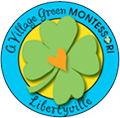
Primary (3-6 Years)
Overflowing with curiosity and questions, a 3-6 year old’s rapidly developing mind absorbs knowledge like a sponge! Using the Montessori approach, our primary program teachers guide this innate eagerness into meaningful and engaging activities that build crucial academic, practical, and social skills. As a result, Village Green alumni thrive in kindergarten, first grade, and far beyond.
Every day, children experience the joy of discovery as they encounter, master, and apply new skills in each of the five multi-sensory classroom areas:

1. Practical Life
The practical life area of the classroom gives children a dedicated place to master essential life skills: caring for themselves, for each other, and for their environment.
In this space, children learn how to sweep, pour, and scrub. They use real-life tools and materials to serve a snack, clean the easel, care for pets, and water plants. They practice dressing to play outside and tying their shoes.
As students improve their concentration, fine motor skills, and coordination, they also achieve greater independence and responsibility – along with increased confidence and self-esteem.
2. Sensorial Enrichment
In this area, materials representing a variety of colors, shapes, textures, sounds, and sizes encourage children to explore and make sense of the world around them.
Through both independent and teacher-led activities, students are introduced to abstract concepts – such as dimension, weight, and gradation – as they interact with a variety of concrete materials. For example, by comparing the lengths of two rods, children learn the concepts of short and long. Other sensorial materials help children to identify thick and thin, heavy and light, rough and smooth, and small and large.
Sensorial activities develop a child’s sense of order and hone his perception and problem-solving. Crucially, they also build a foundation for mathematics as children develop number sense through patterning and sequencing.
3. Math
Attractive concrete materials such as rods, spindles, cubes, tiles, and beads provide children with a hands-on way to explore numeric concepts such as 1-1 correspondence, quantity, place value, and the four basic operations. These experiences help them to develop an intrinsic understanding of quantities before associating them with symbols.
Once students have mastered these fundamentals, they are ready to continue using the materials to work with abstract mathematical concepts such as fractions, and to begin to apply those concepts in authentic situations – for example, how fractions help us to tell time. This real-world approach builds a solid foundation and heightens students’ interest in, and retention of, essential math skills.
4. Language
Reading is the gateway to knowledge, and the entire Montessori classroom is built on this concept. The room is filled with pictures, objects, and puzzles to build children’s vocabulary and awareness of the world around them. Matching activities and class conversations allow the children to reinforce their understanding.
In addition, the primary classrooms include a dedicated language area where students learn the letter sounds, first by tracing sandpaper letters, and eventually creating words using a moveable alphabet. These materials provide an organic and straightforward path into reading. All children receive substantial 1-1 instruction from their teachers, in addition to small-group reading activities.
Since each child has a different learning style, the language area encourages multi-sensory learning: children build verbal skills through listening, speaking, observing their classmates, and handling concrete materials before writing independently.
This holistic approach empowers students to link sounds and symbols at a deep level – resulting in enthusiastic and confident readers and writers.
5. Cultural & Life Science
Here, children encounter artifacts, experiences, and activities that shape their understanding of our world:
- Science, through studying the nomenclature and relationships of biology, as well as basic concepts such as density and magnetism
- Culture & Geography, through experiences with maps, flags, land forms, and heritage; special events expose children to celebrations, foods, and ways of life from around the globe
- Fine Arts, through musical exploration and various creative activities with a variety of artistic media, as well as exposure to the world’s great artists and musicians
Important Dates
FAQs
Yes, to join our Primary program, your 3-6 year old child must be potty trained.
Yes. We have full day programs, along with Early Bird and After School Clubs that run from 7:30 am to 4:30 pm, Monday through Friday.
The outdoors is an extension of the learning environment! Depending on the weather and the enrichment specials schedule, each class spends time outdoors as frequently as possible, typically 30 minutes or more.




